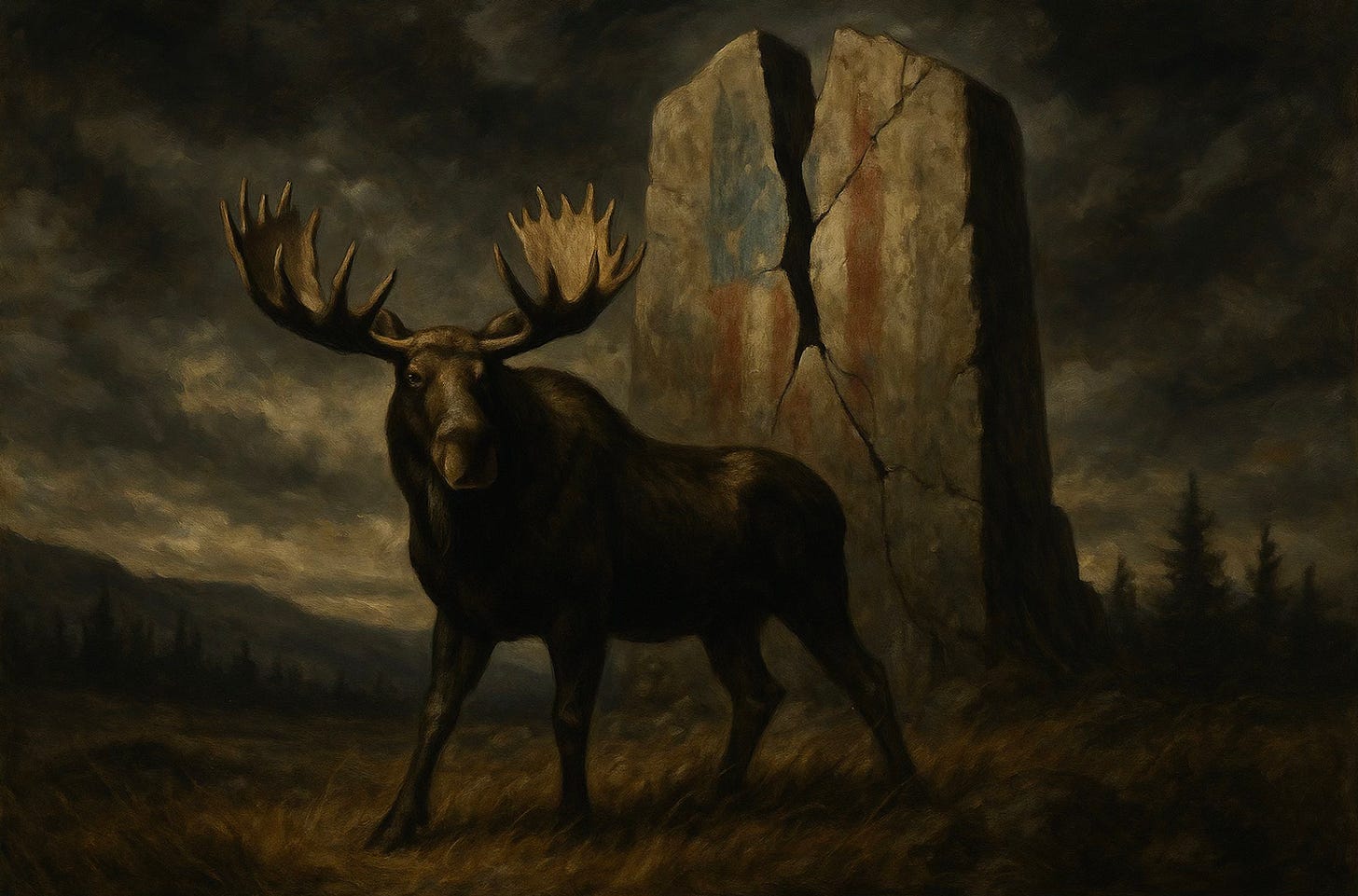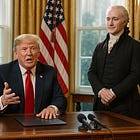"America" and the Burden of Unity
How the United States was rebranded as a monolith and set up for failure.
The violence simmering beneath American politics isn’t just the product of resentment but the product of expectation. The conventional wisdom among political figures and journalists is that divisions within the country are existential because they threaten the unity of a singular, monolithic entity that Teddy Roosevelt would popularize as “America.” Ever since then, unity has become central to the American civic religion—what Roosevelt called “Americanism”—where national harmony is a virtue and signs of difference, ethnic pluralism, and federalism pose obstructions or existential threats to a prosperous America. Today, it would seem that the divisions within the country are differences, tolerable if not benign, that are aggravated by an insistence on a unity that has come to feel like an imposition of one defining vision over another. After over a century of political centralization, it’s worth examining the forfeiture of a self-governed United States for a mythical “America” that only exists in our imagination.
In the early republic, identity was layered, not singular. People were Virginians, New Yorkers, or Pennsylvanians first—citizens of local communities that made the Union possible. Madison wrote in Federalist No. 45 that federal powers would be “few and defined,” while those of the states would be “numerous and indefinite.” Jefferson trusted government closest to its citizens; Washington urged unity but warned against “overgrown domination.” Localism was not fragmentation but liberty’s architecture—proof that a diverse people could coexist under one constitutional roof. When Tocqueville visited in the 1830s, he saw democracy alive in communities and associations. “The strength of free peoples,” he wrote, “resides in the township.” The early United States thrived because it did not demand sameness. It was a political covenant, not a moral creed—confident that freedom could survive without uniformity.
Unity, at the founding, was meant as a safeguard, not an ideology. The new republic needed coherence to collect debts, defend borders, and manage trade among quarrelsome states. The Civil War brought that logic to its breaking point. Lincoln confronted an existential crisis with tools the Constitution had never anticipated: suspending habeas corpus, expanding the army without authorization, censoring opposition papers. These were extraordinary acts for an extraordinary moment, yet they left an indelible precedent—that democracy might need to act undemocratically in the name of unity.
In his First Inaugural, Lincoln cast the Union itself as perpetual writing that “perpetuity is implied, if not expressed, in the fundamental law of all national governments.”
This moral claim disguised as law became the war’s philosophical center. Radical Republicans such as Charles Sumner and Thaddeus Stevens called the Union “organic and perpetual,” a fiction that justified occupation while denying secession. Even after victory, Southern states were deemed never to have left yet were barred from Congress until they ratified the Reconstruction Amendments. In Texas v. White, Chief Justice Salmon Chase declared the Union “indestructible,” closing the circle.
Political theorist Clinton Rossiter later observed that democracies often suspend themselves to endure—what he called “constitutional dictatorship.” Lincoln, he argued, “stretched the Constitution to the limit” to save it. The writer Robert Penn Warren saw the moral consequence: victory gave the Union a “treasury of virtue,” a sense that righteousness could excuse any future overreach. Together, these ideas formed a habit—the belief that the Union’s survival proved its moral destiny, and that destiny could justify whatever power preserved it.
Notably, Lincoln’s claim of perpetuity of all countries was extraordinary for his time and remains extraordinary now. In the 1850s, few nations imagined themselves eternal. Britain’s union was political, not metaphysical; France reinvented itself repeatedly without believing the nation had died; Italy, Germany, and Switzerland were held together by consent, not divine permanence. Lincoln’s insistence on an indestructible Union blurred the line between constitution and covenant. Even today, few federations share it. Canada allows for negotiated secession; Switzerland calls its federation permanent but voluntary; the European Union enshrines the right to leave. The United States stands almost alone in treating endurance as destiny.
By the time Roosevelt entered the presidency in 1901, the centralization born of the Civil War had become habit. He turned that inheritance into moral creed. Roosevelt’s nationalism was not cynical—it was fervent, confident, and missionary. In an age of industrial disorder and corporate excess, he cast the nation as a living organism whose vitality depended on unity of spirit. In “True Americanism,” he drew a line between those who merely lived in the United States and those who belonged to it: “We have room for but one flag… and but one loyalty.” It was a creed of inclusion through assimilation, a democracy that demanded moral uniformity as its price of admission.
In “The Strenuous Life,” he elevated struggle to gospel. Hardship was not to be avoided but embraced; through it a people proved their worth. Roosevelt believed that a strong citizenry would forge a strong nation—and that a strong nation had a moral duty to assert itself. This conviction shaped his imperialism. Expansion abroad was, to him, an extension of moral character: a vigorous nation should shoulder the burden of civilization, even by conquest. His defense of America’s war in the Philippines and the construction of the Panama Canal were not pragmatic acts of statecraft but expressions of destiny. “The American people,” he said, “should face the future steadily, ready to do their duty wherever and whenever it becomes necessary.”
That same belief guided his view of domestic power. Roosevelt saw federalism less as a safeguard than as a constraint. State governments, he argued, had become “machines of stagnation,” too beholden to local interests to serve the public good. In The New Nationalism, he dismissed “states’ rights” as an excuse for inaction, insisting that only the federal government could act “for the common good.” Two years later, in The Right of the People to Rule, he charged that legislatures had become obstacles to democracy, claiming that the presidency alone represented the entire people.
This faith in national virtue reshaped the presidency into a vessel of moral command. The “bully pulpit” gave Roosevelt a direct line to the people, bypassing intermediaries—Congress, party, and press alike. He governed through exhortation and spectacle, casting himself as the nation’s conscience as much as its executive. It was a form of charismatic democracy that blurred the line between moral leadership and authoritarian temptation. Roosevelt spoke the language of the common good but often treated disagreement as weakness and checks on his power as affronts to it.
In 1915, at Carnegie Hall, he declared, “There is no room in this country for hyphenated Americanism… A hyphenated American is not an American at all.” His message was meant to inspire, but it revealed the cost of his creed. Roosevelt’s Americanism left little room for the pluralism that had defined the early republic. He offered unity as a moral good but planted the idea that allegiance and virtue were one and the same—a notion that still haunts American politics, where loyalty to one vision of the country so easily becomes a test of belonging itself.
Centralization would accelerate under Roosevelt’s cousin as he and overwhelming congressional majorities navigated crises like the Great Depression and World War II, that also set a lasting precedent that the federal government should define and direct the national good. Successive leaders deepened this orientation. J. Edgar Hoover’s FBI pursued ideological conformity in the name of American security; Lyndon Johnson’s Great Society expanded Washington’s reach into nearly every facet of public life. Their motives were often noble—security, justice, equity—but each built on a centralizing habit that equated federal power with national virtue. These developments and those like them are regarded as progress more than they are foreshadowing of our contemporary struggles with identity and the role of legally-binding authority be it on immigration, during a pandemic or the latest culture war.
Crucially, transformations in the media ecosystem have bolstered the conceit of a singular “America”. National broadcasts collapsed regional distinctions into a shared set of symbols, rituals, and narratives, while cable and internet news created a constant sense of collective crisis. As audiences fragmented, media responded not by localizing content, but by doubling down on making those local developments everybody’s business from coast to coast. The result is a political culture that frames every issue through the lens of one imagined public, flattening regional realities and fueling the notion that disagreement threatens the integrity of the whole.
Roosevelt’s “Americanism” now underwrites nearly every political ritual we perform. Our entire public discourse operates on the “America” pretense—one that burdens each citizen with the impossible goal of unifying across six time zones, fifty governments, and 340 million lives. Every issue must be national; every controversy a referendum on what kind of country we are. Ordinary disagreement feels existential because the nation has made an elusive consensus a condition of belonging. The result is exhaustion and high stakes that drive people to the brink. Polarization becomes the natural byproduct of a republic that mistakes moral unity for civic health.
In many ways, the moral and economic diversity of the United States has outgrown the machinery of a single national consensus. A modern form of dual federalism—one that grants states broad autonomy not out of nostalgia but necessity—would acknowledge that pluralism, not unanimity, is the republic’s natural state.
Local authority, by contrast, allows adaptation, experimentation, and trust to reemerge where national politics have created incentives that push local lawmakers to toe national party lines—a trend that has saddled local elected officials with the baggage of national party brands. A renewed federalism would not fracture the nation but preserve it—by allowing Americans to live differently without having to live apart. Americans could visually and orally elevate their local and state identities to place themselves in the civic mindset of seeking to participate in governing their own backyard before they reflexively burden themselves by pursuing an insurmountable national consensus.
A renewed federalism need not mean retreating from national coordination on major issues, particularly defense, maintaining a currency or protecting civil rights. A modern revival of federalism would also not be nostalgic or resort to how “the Founders intended” for things to be. After all, the Founders—both Anti-Federalists and Federalists—advanced ideas and enshrined clauses in the Constitution that sought to centralize power that later became decentralized, decentralized power that later became centralized, and limited power that later expanded. All of them, however, though they disagreed vehemently, operated on the premise that authority should be dispersed. The circumstances today justify resurrecting that fundamental American idea arguably more than it did at a time when the Union was still vulnerable to attack by its oppressors.
Roosevelt sought to make the United States worthy of its promise. But in sanctifying unity, he taught the republic to expect too much from itself—to confuse moral consensus with democratic health. The more the United States pretends to be a singular America where it is not, the greater risk will come from placing the hand of unity over the vents of an already heated polity.







A European once remarked that the U.S., for a young country, has a very old constitution. Have we become a "zombie" nation, still animated beyond our demise?
The author describes the transition of the nation from a union of states to become a federalized United States able to meet the challenges of a changing world. Our Constitution may remain relatively stable, but the events surrounding us certainly have not. Perhaps an 18th century document that was revolutionary in its time has become woefully inadequate for the 21st century and beyond?
It seems the tipping point was in the 1800s when revolution and turmoil in Europe and the rise of the Industrial Revolution in the U.S. opened the floodgates to massive immigration and subsequent loss of local community identity. Lincoln's bold acts of federalization forced the country back together against its natural will. The Confederate battle flags prominent at the January 6 Insurrection were evidence that Reconstruction failed and that the Union was a national myth rather than reality.
Russian Senior Advisor, Georgi Arbatov, warned the U.S. at the end of the Cold War and the fall of the USSR. "We are going to do a terrible thing to you; we are going to deprive you of an enemy."
I made an observation that currently the U.S. government only works when it is at war, giving "war powers" to the President as Lincoln modeled during his time. Trump and the Project 2025 authoritarians have taken full advantage of this "loophole" that was beyond the imaginations of the Founding Fathers. Trump simply creates a "national emergency" to justify any authoritarian action he desires. Yes, it borders on the absurd as Portland's cartoonish mockery exposes, but any MAGA opposition now is deemed "treasonous" and a declaration of war.
As the Pogo cartoon character remarked, "I have seen the enemy, and he is us."